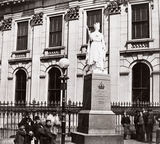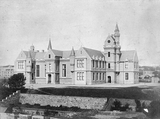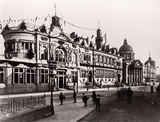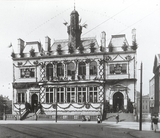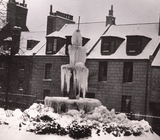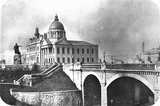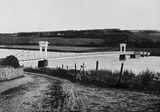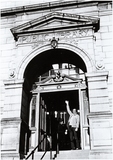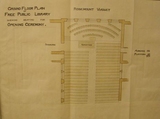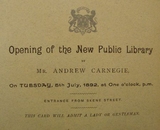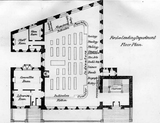|
Quick Search
|
Search Results
You searched for: More Like: 'Aberdeen Central Library Staff 1892'
178 items
items as
Denburn Valley
48 The Denburn Valley Railway, shown here on the right, was constructed in 1865-67. It runs from the Joint Station at Guild Street north through the valley. To the left of the railway lines is Union Terrace Gardens which were opened to the public on 11th August 1879.
The closeness of the railway led to the gardens being nicknamed the "Trainie Park". The bandstand shown here in the centre of the park was removed in around 1931.
The iron footbridge visible in this image allowed access over the Denburn and railway between Rosemount and the city centre. It was replaced by the Denburn Viaduct which was built in 1886, at the same time as Rosemount Viaduct, by engineer William Boulton. Part of the footbridge was moved and reassembled in the newly created Duthie Park.
This image also predates the construction of significant buildings on Rosemount Viaduct such as the Public Library and the Free South Church (both dating from 1892). In the background, on the left of the image can be seen the houses at the foot of a then longer Skene Terrace. These are on the site later occupied by the library and church.
To the right of those houses are Black's Buildings. Local historian Diane Morgan explains that they were "a small curving crescent of tall tenements, four and five storeys high, [and] sat below the Royal Infirmary, Woolmanhill, just west of the apex of the Woolmanhill triangle. (...) The houses were built in stages between 1789 and 1830, by the wine merchant James Black." (Lost Aberdeen: Aberdeen's lost architectural heritage, 2004). The tenements were pulled down in 1957.
Woolmanhill Hospital, designed by Archibald Simpson and built 1832-1838, can be seen in the background. Chimneys of Broadford Works, the textile factory located between Ann Street, Maberly Street and Hutcheon Street, are also visible. Statue of Queen Victoria
73 A photograph showing the statue of Queen Victoria at the junction of Union Street and St. Nicholas Street. The building in the background is the Clydesdale Bank that stands next to M&S today. This fine Italian renaissance style building was originally constructed for the Town and County Bank and opened for business in May 1863.
The statue of Queen Victoria was made from marble and was sculpted by Banff born Alexander Brodie (c.1829 - 1867). The origin of this statue is closely related to another Aberdeen monument, the 1863 memorial statue of Prince Albert by Baron Marochetti, now standing, or rather sitting, in the area in front of the Central Library.
Marochetti's statue was augurated by Queen Victoria herself on 13th October 1863 and this was said to the first time the Queen had appeared at a public demonstration following the death of Albert in 1861. The Marochetti statue was the subject of great local controversy and there were various plans for an alternative, superior, memorial to the late Prince Consort. It was at a related meeting that a chap called Alexander Donald, from the Royal Tradesman of Aberdeen, moved "That a colossal statue in marble, of Her Majesty, be erected at the corner of St. Nicholas Street."
The endeavour was taken on by a variety of prominent citizens and funding was raised by public subscription. Brodie, the selected sculptor, worked on an 11-ton block of Sicilian marble for two years to complete the statue. The finished piece is 8 foot 6 inches in height and, at the request of Queen herself, depicts Victoria in Scottish regal attire. The statue stands on a substantial plinth of pink Peterhead granite.
The statue was unveiled and inaugurated on 20th September 1866 by Albert-Edward Prince of Wales, later to be King Edward VII and the subject of another of Aberdeen's notable statues. During his speech at the ceremony, the Prince said "Gentlemen, it has afforded me the greatest satisfaction to attend here today, by the wish of Her Majesty, and at your invitation, for the purpose of inaugurating a statue of the Queen, my dear mother. Her Majesty has desired me to express to you how much she appreciates the motives which have led the people of Aberdeenshire to give this lasting evidence of their attachment and loyalty to her person, of which she has so many proofs, and whose sympathy in her great sorrow has touched her so deeply."
During his visit, the Prince of Wales also received the Freedom of the City and attended the Royal Horticultural Society's Autumn Show, which was then going on in the Music Hall. An extensive account of the unveiling, the Royal visit and the town's celebrations is given in the Aberdeen Journal of 26th September 1866.
After some time at this location, the statue's marble began to show weathering due to the frost and so it was moved to the vestibule of the Town House in 1888, where it remains to this day. It stands at the foot of the building's splendid main stairway. The plaster model of Brodie's statue has also been on display in the Music Hall for many years.
A new bronze statue of an older Victoria, by sculptor Charles Bell Birch, was erected at the St. Nicholas Street location on 9th November 1893 and "the Queen" became a regular meeting place for generations of Aberdonians. To make way for the extension of Marks & Spencer, the 1893 statue moved to its current site at Queen's Cross on 22nd January 1964. Victoria now stands looking east towards Balmoral. Aberdeen Grammar School
105 Aberdeen Grammar School, Skene Street, c.1860. This view shows the school which was built by Aberdeen Town Council in Skene Street and opened in October 1863 to replace the old school in Schoolhill. In later years, a statue of Lord Byron was placed in front of the school to commemorate the fact that he attended the old Grammar School in the 1790s. The walls in the foreground indicate where the Denburn used to flow before it was covered over. In July 1986, much of the central area of the school, including the library, was severely damaged by fire and some valuable material was lost. Rebuilding was completed by 1992. Rosemount Viaduct
134 Rosemount Viaduct, showing the William Wallace statue, the South Church and the Central Library, c.1900 prior to the building of His Majesty's Theatre. Interior of King's College Chapel
139 Interior of King's College Chapel, University of Aberdeen, Old Aberdeen, c.1900. King's College was founded by Bishop William Elphinstone under a Papal Bull issued by Pope Alexander VI on 10th February 1495. Marischal College was founded as an independent university in 1593 and the two became the University of Aberdeen in the Fusion of 1860. Work began on the College in 1500 and it took 6 years to complete the Chapel. This photograph shows the interior looking west, showing Bishop Stewart's pulpit on the right, through the nave and choir to the choir stalls and rood screen, with the antechapel behind it. Non-residents entered through the west door and occupied the antechapel, while students entered from the College Library via a special staircase within the rood screen. The central gallery of the screen is still used to house the organ. The 52 choir stalls, commissioned by Elphinstone, are "a unique survival as well as the finest of their king in Scotland". The finely panelled Renaissance pulpit of William Stewart (Bishop 1532-1545) bears his coat of arms and was originally in use in St. Machar's Cathedral. The timber ceiling was constructed soon after 1506 and was probably designed by John Fendour. It consists of a diagonal arrangement of ribs and widely spreading foliage sprigs radiating from centre bosses. The choir stalls and ceiling both show a strong Flemish influence. The Chapel is still in use today for University services and is a popular marriage venue for graduates. Well of Spa
175 In 1615 Dr. William Barclay wrote a treatise extolling the virtues of the Well of Spa and commending the use of its waters to invalids. Then George Jamesone, the artist, while suffering from calculus of the bladder found relief from the mineral qualities of the well. At the beginning of the 20th century, the well was removed and re-erected inside the wall of the old Royal Infirmary at Woolmanhill and water was introduced into it from another source. Later it was moved to a nearby site behind Aberdeen Central Library, beside the Denburn Car Park. Aberdeen Central Library, Rosemount Viaduct
276 Aberdeen Central Library, Rosemount Viaduct decorated seen from Skene Terrace. Demonstration in favour of the Franchise Bill
318 On the 16th August 1884, a great demonstration took place in Aberdeen in support of the Franchise Bill. Over 10,000 men including members of 33 different trades, assembled on the Esplanade and, to the music of 20 bands, paraded through the city street on way to the Links. This photograph shows the processions snaking down Guild Street.
The figures dressed in white towards the front of the procession are likely from the contingent of bakers and millers, of whom there were 300 in number. This may be the end of their group, with a band and the shore labourers behind them.
Describing the procession, the pamphlet The Franchise Bill Demonstration at Aberdeen, on Saturday, 16th August, 1884 states the following:
"The millers and bakers, who came next, presented, perhaps the best show in the whole procession. Dressed in white from head to foot, they made a strikingly conspicuous display amid the variegated draping of the other demonstrators." (Page 7).
The pamphlet goes on to describe the various banners and displays carried by the millers and bakers.
Aberdeen City Libraries have a copy of The Franchise Bill Demonstration at Aberdeen, on Saturday, 16th August, 1884 in our Local Studies Reserve Stock (Lo 329) and this can be consulted at Aberdeen Central Library. The pamphlet states that it is compiled chiefly from local newspaper reports. Aberdeen Central Library
333 Aberdeen Central Library was designed by George Watt but has been added to over the years.
This image shows the library decorated for the city's celebrations of the coronation of Edward VII and Queen Alexandra that were held on Saturday 9th August 1902. The new monarchs had been crowned the previous year.
The decorations on Schoolhill and Rosemount Viaduct were carried out under the direction of Mr Stewart, superintendent of Stewart Park.
See the Aberdeen Daily Journal of Monday 11th August 1902 for an extensive report on the coronation celebrations. Library Fountain
688 Library Fountain which stood adjacent to the original Central Library building. It was removed to make way for the extension which housed the Commercial Library, later known as the Business and Technical Department and subsequently as the Media Centre. Queen's Gardens
721 This G.W. Wilson photograph shows the row of terraced houses built in the West End of Aberdeen in the late 1870's. They were designed by J. Russell Mackenzie. The granite houses had three bays with wrought iron balconies at first floor level. The central and end houses were designed by Ellis and Wilson around 1884 - they have bay windows with a pediment above. The 1892 Census shows that the occupants included an advocate, and a wine merchant with houses having 14, 18 or 22 rooms. Today most of the buildings have been converted into offices. At the right can be seen the spire of Rubislaw Church, designed in 1874, also by Mackenzie. Rather strangely, it is made of sandstone, especially in an area dominated by granite, and is distinguished by its gothic tower with leaded spire which was added a few years later. Rosemount Viaduct
802 Rosemount Viaduct with (from left to right) Aberdeen Central Library, St. Mark's Church and the statue of William Wallace. Rosemount Viaduct
803 Rosemount Viaduct from Union Terrace Gardens. St. Mark's Church and the Central Library are on the left with the statue of William Wallace pointing towards the site of His Majesty's Theatre. Morison's Bridge
1098 This photograph of Morison's bridge, or the Shakkin' Briggie, is reproduced from the book 123 Views of "Royal Deeside" (1903). This volume was printed and published at the office of the Aberdeen Daily Journal and Evening Express, 18-22 Broad Street, Aberdeen.
The photographs that feature in the book were taken by Mr. William J. Johnston of Rockcliffe, Banchory.
William Jaffrey Johnston (1864-1914) was a professional photographer, considered an expert in outdoor photography, and was well known around Deeside. He was also a church organist, latterly with Banchory's South U.F. Church for 16 years.
Johnston died aged 48 on 13th January 1914. A death notice, brief obituary and tribute from the Rev. W. Cowan can be found in the local newspapers of the time.
An article about the release of the album of views can be found in the Aberdeen Daily Journal of 1st June 1903 on page 5. Copies of the book can be consulted in the Local Studies collection at Aberdeen Central Library.
The description that accompanies this image of the bridge reads as follows:
"Cults Bridge was erected in 1837, so that parishioners on the north side of the river might have better means of access to the Church of Banchory-Devenick than the then 'parish boat' afforded. The donor was Rev. Dr. Morison, the minister of the parish. But the growth of Cults has been such that the parish has been re-arranged, and the village has now its own churches." (page 7). Rosemount Viaduct
1196 Aberdeen Central Public Library, St. Mark's Church and the statue of William Wallace all on Rosemount Viaduct. His Majesty's Theatre is yet to be built - opened in 1906. The dome of Aberdeen Royal Infirmary, Woolmanhill is just visible in the background. Aberdeen Central Library
1272 The main doorway to Aberdeen City Libraries Central Library on Rosemount Viaduct. The two people in the doorway are librarians Jean Dodds and Alan Rennie. Aberdeen Central Library 1892
1382 The new Central Library was officially opened by Andrew Carnegie on July 5th 1892 at a cost of £10,000 (about £5m today).
Mr. Carnegie had contributed £1,000 to the building fund and prior to the opening ceremony received the Freedom of the City. Aberdeen Library opening ceremony seating plan
1383 The opening ceremony was held in the new Reading Room on 5 July 1892 where a platform had been erected covered in crimson cloth and decorated with plants and flowers.
The original seating plan is held in Aberdeen City Archives. Aberdeen Library opening ceremony invitation card
1384 Entrance to the ceremony was by invitation only and the crowd "thoroughly representative of all classes of the community".
(Aberdeen Free Press 6 July 1892)
The original entry ticket is held in Aberdeen City Archives. Aberdeen Library opening ceremony luncheon
1385 After the opening ceremony 150 guests adjourned to the Town and County Hall for luncheon. The Library staff were entertained to tea in Mr. Millison's Restaurant in Market Street.
The original luncheon invitation is held in Aberdeen City Archives. Rosemount Viaduct view
1387 A postcard view of the Central Library in 1900 showing the Free South Church (now St Marks) and Wallace Statue. This image pre-dates the building of His Majesty's Theatre. Lending Library Plan, 1892
1390 The Lending Library opened on 12 July 1892. It opened weekdays from 11-8pm (except Wednesday when it closed at 1pm).
There was no direct access to the books. "Indicator Boards" listed books in stock and borrowers had to ask the staff to fetch those they wanted. |




